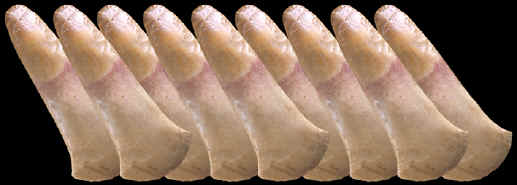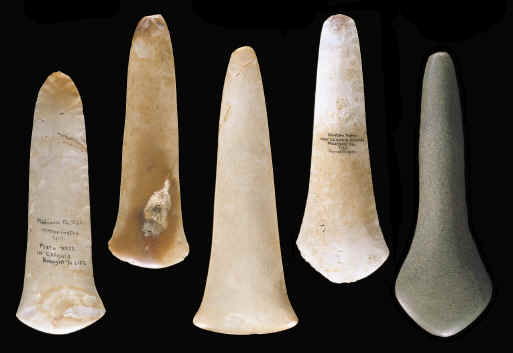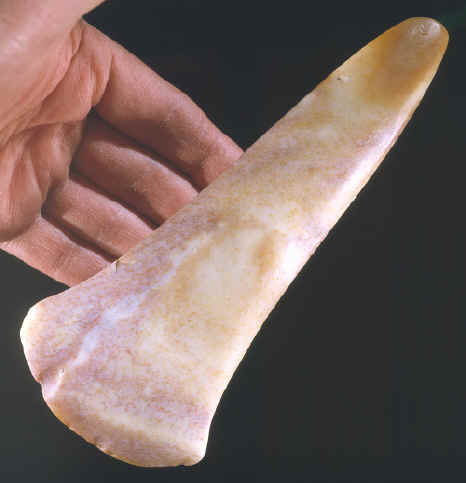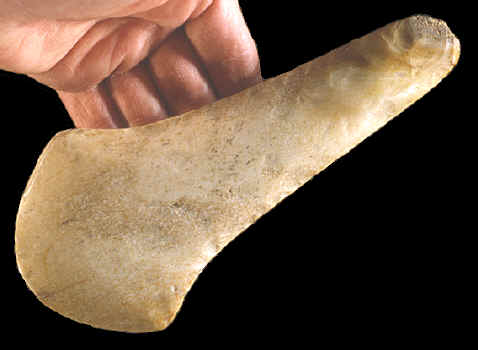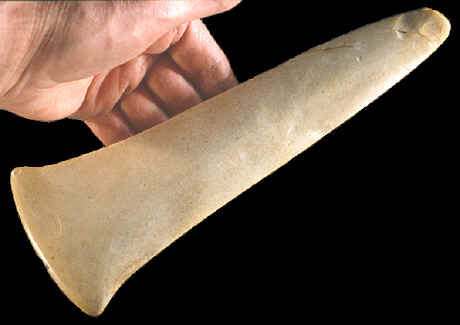|
|
|
Spuds apparently date to the end of the Woodland period. Pecked and ground granite spuds have been found on Jersey Bluff sites that differ in shape from those found at Cahokia. Jersey Bluff spuds have not been found on excavated sites. Spuds continued to be made in various forms throughout the Mississippian period until European contact, when the wide stemmed & perforated class C type of spuds were being made. B. W. Stevens reports that "Frequently this type of ax (spud, class C) has been discovered in mound burials with historic material, such as Venetian glass beads, bronze sleigh bells, copper powder buckets, glass rum bottles and other historic objects. He also writes that "Very likely the battle ax of the early Spanish solders was the incentive that prompted the Indian to imitate in stone this broad blade weapon that captured his primitive fancy." An estimated date for spuds might range between A.D. 720 to 1650. |
|
|
From an article in an early "Wisconsin Archaeologist" Charles E. Brown describes three main classifications of spuds. For Class A he includes the longest spuds, such as the "Grove spud" described farther below. These spuds have broad semi-circular blades that angle 90 degrees out from the handle, or have blade shoulders that slope downward or they can have barbs that angle upwards towards the handle. Class A spuds have long handles that are either circular or elliptical in cross-section. Some of them have been described as "broom handles." They range in size up to 22 3/4 inches long. |
|
|
|
|
Class B spuds include most of the examples illustrated in this article. Brown describes them as "Blade generally short, crescent-shaped or oval, convex or flat, reduced to a sharp cutting edge, shoulder when present also partially edged; handle generally of short or medium size, of nearly uniform width, circular, elliptical, less frequently square or somewhat rectangular in (cross-)section. |
|
|
|
|
For class C spuds Brown includes all the wide flat stemmed and perforated examples from the southeastern states from Arkansas through Tennessee, Mississippi and farther east. He describes them as "broad flattish implements." and as "blade broad, nearly circular, elliptical or semi-elliptical in shape, edge fairly thick and smooth, or thin and sharp, shoulders rounded or sharply pointed; handle narrower than the blade, flat or convex, sides straight or curved, parallel or slightly tapering to the top." |
|
|
|
|
Stone spuds were made from several different kinds of materials. Included in this list are the thin, wide and perforated type C from the southeastern states. Spuds were made from Burlington chert, Kaolin chert, steatite, slate, quartzite, fine grain sandstone, diorite and fine grained greenstone. The two basic types of materials used were chert and granite. |
|
| CONTINUE ON TO PAGE THREE | |
|
"REFERENCES"
1910,
Moorehead, Warren K., "The Stone Age In North America," Vol. 1,
Chapter XXII, "Ground Stone---Problematical Forms, The Spud-Shaped
Implement," pp. 418-430. |
|
